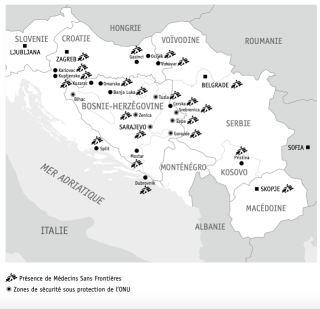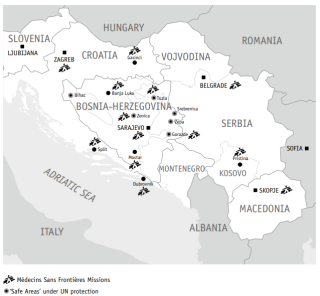Discover all our latest news, stories and publications. Use the filter to get to the content you're looking for.

مجموعة الدول السبع: العالم اليوم لا يزال غير مستعد لمواجهة فيروس إيبولا

Testimonies from displaced people in Khamer

“Many civilians are injured and killed by the ongoing crisis.”

Crisis update – 2 June 2015

MSF helicopter crashes in Nepal

تحطم طائرة مروحية

MSF concerned with the rapid spread of the cholera outbreak

Ebola accountability report: An unprecedented year

A nurse in Old Fangak

Psychological first aid helps Nepalese rebuild their lives
MSF et Srebrenica 1993-2003
Toutes les études de cas sur les prises de parole publiques > MSF et Srebrenica 1993-2003
L’étude de cas 'MSF et Srebrenica 1993-2003' s’intéresse aux contraintes, questionnements et dilemmes posés par les prises de parole publiques de MSF concernant l’enclave musulmane de Srebrenica, qui fut assiégée à partir de 1993 puis conquise en juillet 1995 par les forces bosno-serbes. 8000 hommes et adolescents de plus de 16 ans y furent massacrés malgré la présence des forces de maintien de la paix des Nations-Unies, censées protéger la population de cette enclave déclarée « zone de sécurité ». MSF, dont les équipes ont été présentes dans l’enclave pendant toute cette période, témoigna des évènements et demanda ensuite publiquement que des enquêtes soient menées par les différents Etats impliqués afin de déterminer les responsabilités politiques et militaires dans la chute de l’enclave et l’abandon de sa population.
Dilemmes et questionnements:
- En acceptant d’apporter des secours a minima à une population assiégée, est-ce que MSF a contribué à la stratégie des assiégeants ?
- Fallait-il demander l’évacuation de la population civile qui le souhaitait au risque de cautionner la politique d’épuration ethnique menée par les assiégeants ?
- Ayant fait confiance à l’engagement de protection de l’enclave et de sa population par les Forces des Nations unies, est-ce que MSF doit assumer une part de culpabilité ou de complicité dans l’abandon de l’enclave par l’ONU et le massacre de la population qui s'en est suivi ?
- Est-ce que MSF a donné à la population, la fausse impression que rien ne pouvait lui arriver tant que ses équipes étaient présentes ?
- Est-ce le rôle d’une organisation médicale humanitaire de lancer un appel à une commission d’enquête parlementaire puis, celle-ci mise en place, d’en assurer un suivi actif critique ?
- A l’inverse, est-ce que MSF pouvait ne pas chercher à comprendre les circonstances et les responsabilités qui, au niveau international, ont mené à l’abandon et au massacre d’une population à laquelle ses équipes portaient secours ?
- Est-ce que MSF pouvait se contenter de lancer un appel à une enquête parlementaire sans s’assurer que celle-ci se pose des questions susceptibles d’apporter des réponses éclairantes sur les événements ?
- Le cas de Srebrenica doit-il être conçu comme un accident de l’histoire ou comme un modèle irréductible de l’impossibilité des mandats internationaux de protection des populations développé par l’ONU ?


MSF and the War in the Former Yugoslavia 1991-2003

Violence against Kosovar Albanians, NATO's intervention 1998-1999

War crimes and politics of terror in Chechnya 1994-2004


MSF and Srebrenica 1993-2003
All Speaking Out Case Studies > MSF and Srebrenica 1993-2003
The case study ‘MSF and Srebrenica 1993-2003’ explores the constraints, questions and dilemmas raised when MSF spoke out about the events that occurred in Srebrenica’s Muslim enclave. The enclave was besieged in 1993 and then seized by Bosnian Serb forces in July 1995. 8,000 men and young men over the age of 16 were massacred, despite the presence of the United Nations Peacekeeping forces supposedly providing protection in what had been declared a "security zone". With teams present in the enclave throughout, MSF testified to what happened and called on the various countries involved to hold inquiries and establish where military and political responsibility lay for the fall of the enclave and abandon of the people of Srebrenica.
Questions and dilemmas:
- By agreeing to provide a minimally acceptable level of relief to a besieged population, wasn’t MSF contributing to the strategy of the besieging troops while concurrently softening their image?
- Could MSF call for the evacuation of civilians who wished to leave thereby risking abetting the ethnic cleansing policy of the besieging army?
- Having trusted the UN Protection Force’s commitment to protect the enclave and its population, must MSF accept partial culpability for or complicity in the UN’s abandonment of the enclave and the ensuing massacre of the population?
- Didn’t MSF give the population the false impression that it would be safe as long as the team was present?
- Is it the role of a humanitarian medical organisation to issue an appeal for an investigative parliamentary commission then, once it is established, to actively monitor it with a critical eye?
- Contrarily, how could MSF not try to understand the circumstances and responsibilities, which, at the global level, led to the abandonment and massacre of a population to which its teams had provided relief?
- Could MSF be content with calling for a parliamentary investigation without ensuring that it asks the types of questions likely to elicit answers that shed light on the events?
- Should Srebrenica be viewed as an accident of history or as a clear-cut example of the impossibility of protecting populations under international mandates established by the UN?

Speaking Out: Srebrenica podcast
msf.org"Speaking Out Srebrenica" podcast is adapted from the "MSF in Srebrenica, 1993-2003" case study. The 5-episode podcast series examines the constraints, questions and dilemmas surrounding speaking out that the MSF teams faced during the siege and subsequent massacre which took place in Srebrenica during the Bosnian War of the 1990s.

MSF and the War in the Former Yugoslavia 1991-2003

Violence against Kosovar Albanians, NATO's intervention 1998-1999

War crimes and politics of terror in Chechnya 1994-2004

MSF and Srebrenica 1993-2003 - Cloned
All Speaking Out Case Studies > MSF and Srebrenica 1993-2003
The case study ‘MSF and Srebrenica 1993-2003’ explores the constraints, questions and dilemmas raised when MSF spoke out about the events that occurred in Srebrenica’s Muslim enclave. The enclave was besieged in 1993 and then seized by Bosnian Serb forces in July 1995. 8,000 men and young men over the age of 16 were massacred, despite the presence of the United Nations Peacekeeping forces supposedly providing protection in what had been declared a "security zone". With teams present in the enclave throughout, MSF testified to what happened and called on the various countries involved to hold inquiries and establish where military and political responsibility lay for the fall of the enclave and abandon of the people of Srebrenica.
Speaking Out: Srebrenica Podcast
“Speaking out: Srebrenica podcast” is the first series of a collection of podcasts based on the MSF Speaking Out Case Studies series. This new series comprised of 5 podcasts examines the challenges and dilemmas surrounding speaking out, the MSF teams faced during the siege and subsequent massacre that took place in Srebrenica during the Bosnian War of the 1990s.
Questions and dilemmas:
- By agreeing to provide a minimally acceptable level of relief to a besieged population, wasn’t MSF contributing to the strategy of the besieging troops while concurrently softening their image?
- Could MSF call for the evacuation of civilians who wished to leave thereby risking abetting the ethnic cleansing policy of the besieging army?
- Having trusted the UN Protection Force’s commitment to protect the enclave and its population, must MSF accept partial culpability for or complicity in the UN’s abandonment of the enclave and the ensuing massacre of the population?
- Didn’t MSF give the population the false impression that it would be safe as long as the team was present?
- Is it the role of a humanitarian medical organisation to issue an appeal for an investigative parliamentary commission then, once it is established, to actively monitor it with a critical eye?
- Contrarily, how could MSF not try to understand the circumstances and responsibilities, which, at the global level, led to the abandonment and massacre of a population to which its teams had provided relief?
- Could MSF be content with calling for a parliamentary investigation without ensuring that it asks the types of questions likely to elicit answers that shed light on the events?
- Should Srebrenica be viewed as an accident of history or as a clear-cut example of the impossibility of protecting populations under international mandates established by the UN?
Speaking Out: Srebrenica podcast


Even after the UN declared the city a ‘safe area’ in March 1993, the Muslim population trapped inside Srebrenica is living under constant shelling. MSF is providing medical care but is starting to question how much protection the UN can actually provide?
Episode 1

MSF is the only source of medical care in Srebrenica. The violence worsens. MSF wonders if it’s contributing to the Bosnian Serbs’ strategy, acting like prison doctors? Should calling for the evacuation be the equivalent of abetting the Bosnian Serb’s ethnic cleansing policy of driving out all Muslims and claiming the land? Even if those same civilians want to leave.
Episode 2

July 1995 - the fall of #Srebrenica. Around 8,000 men and boys massacred. How can this happen with UN peacekeeper in a so-called ‘safe zone’? What mechanisms did MSF put in place to speak out over the UN’s inability to protect the people of Srebrenica?
Episode 3

Following the fall of Srebrenica, a so-called UN “Safe zone”, thousands are dead, missing or in refugee camps. Where does the responsibility lie for the inaction? What can MSF do to make sure that peace does not take precedence over justice?
Episode 4

Justice is slow. Many of the nations involved are not taking responsibility for their actions in the enclave. MSF France puts pressure on the French parliament to investigate France’s role in the fall of Srebrenica. However, is it really the role of a humanitarian organisation to issue an appeal for an investigative parliamentary commission?
Episode 5

MSF and the War in the Former Yugoslavia 1991-2003

Violence against Kosovar Albanians, NATO's intervention 1998-1999

War crimes and politics of terror in Chechnya 1994-2004


Migration: Search and Destroy does not save lives

The Situation in Lugansk

Gallery: Medical care in Debaltseve

MSF forced to close Dadaab health posts and evacuate staff amid escalating insecurity

New wave of refugees fleeing ongoing violence in South Sudan

MSF staff relocated following incidents in Dadaab

Vaccine shortages causing delay in the fight against meningitis

Activity Update, May 2015

MSF provides assistance to the displaced and refugees in Kurdistan

Experts support a varied approach to Ebola trials

How we deliver medical humanitarian assistance
Everywhere we work, the circumstances are unique. Nonetheless, our programmes generally follow a common set of practices designed to make sure our resources and expertise are used to maximum effect.




